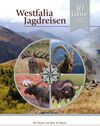Clothing and Shoes
• Long pants and shirts, lightweight, durable, not too light (olive or hunting camouflage)
• against cold: warm jacket (functional jackets with Windstopper membrane)
• Hat with wide brim
• Do not bring a lot of clothes (daily laundry service - on the farm and also in the wild hunting) Good shoes are especially important in every active hunting. Depending on the game you can walk long distances. Buffalo and elephant hunts are tough, but antelope hunts (such as Eland or special mountain hunts) can be miles long.
Our tip: Always take two pairs of well-worn hunting boots with you. These should dampen and also give stability to the joint. Shoes such as the "Desert Boots" from Haix have proven themselves. Also use good functional socks.
Hints
• African game is tough, the heart is lower in most game species than in European game.
• Discuss with the professional hunter the anatomy of the game and the location of the shot.
• Before starting hunting with the professional hunter, make your preferences: game species, hunting species, etc.
• For buffalo hunting: use full-wall projectiles and hard sheaths. Discuss the charge with the professional hunter (example: 1st shot of full coat, 2nd partial coat, 3rd full coat).
• In leopard hunting, use soft projectiles that respond quickly, e.g. Norma Oryx.
• Use good hard bullets (Bear Claw or Trophy Bonded, Swift AFrame, Sierra Game King and similar bullets from premium manufacturers) for antelope hunting.
• Only use full-body bullets in elephant hunts. Carry out a detailed study of the anatomy of the skull.
• Make sure you drink enough! Even without much walking, you will lose a lot of fluids in the heat of Africa. Four to six liters are the absolute minimum of the day!
• The lips dry out very quickly in the thin air of Africa. Small but very useful:
A lipstick (eg Blistex) is part of every standard equipment.
• Take cable ties with you - can be used flexibly
Traveling with a rifle
• The rifle must be registered with the airline.
• Weapon and ammunition: transport separately and give up
• Ammo: Take 40 to 60 rounds
• Remove the scope, not in your hand luggage!
• At Departure Airport: Register your rifle at the special baggage counter to have it checked by the BGS
can be.
• At the destination airport: Register the rifle here as well. Keep the document handed to you by the police until you leave!
Shooting from a stick
• In Africa you will often stalk and then shoot from the stick. The local professional hunter has his own shooting range.
• Train before shooting a shooting range before the trip.
• Train at home with a firing stick. Probefests and the repeated installation of the shooting stick as well as the quick application of the rifle give security.
• Practice in the hunting area before the start of the hunt with the shooting stick available there. Involve the professional hunter, who can offer you the shoulder as additional support for your arm / elbow when you hit it.
• Use ear protection when shooting.
• The more you practice, the better you will shoot. This security helps you with the safari at the crucial moment!
Weapon, Optic
• Robust systems are less susceptible to interference! Have proved successful repeaters based on the 98ers.
But more important than a strong caliber is that you are familiar with the weapon.
• Minimum energy for small antelopes: 1,350 joules, for medium-sized antelopes such as kudu, oryx or eland: 2,700 joules and for large game such as buffalo, hippo and elephant: 5,400 joules.
• Antelope Hunt: universal caliber like .300 Win. Mag., 8x68S or 9.3x64 cover the entire range
from antelopes
• A .375 H & H can be used as the universal caliber for all game species.
• Big Game / Big Four: Minimum caliber (required by law): .375 H & H. To be recommended are stronger caliber like .404 Jeffery or .416 Rigby (more reserve than the .375 H & H, but still moderately shootable)
• Target optics: Riflescopes should be variable, small in size, but large in field of vision (Swarowski,
Zeiss, Leica, Kahles, Schmidt & Bender et al. offer good products)
• Binoculars: a light glass (8x magnification) is enough.
Tip: Use a shoulder strap (spreads the weight over the shoulders) and the binoculars will not disturb you when stalking or shooting, as it will be fixed in front of your chest.
Conclusion: Crucial is the safe first shot! A well-placed ball of a smaller minimum caliber is better than a very large caliber that you can not shoot clean!
Wilderness hunt
Take the emergency medication with you every time you go for a walk, as well as the GPS and satellite phone (if available).
Useful equipment in the wilderness
• GPS (eg Back Track)
• Satellite phne
• Multitool (eg Leatherman)
Can I take the trophies with me?
All trophies in Africa will be sent out at the end of the season. For veterinary reasons, it is forbidden to take trophies directly.










